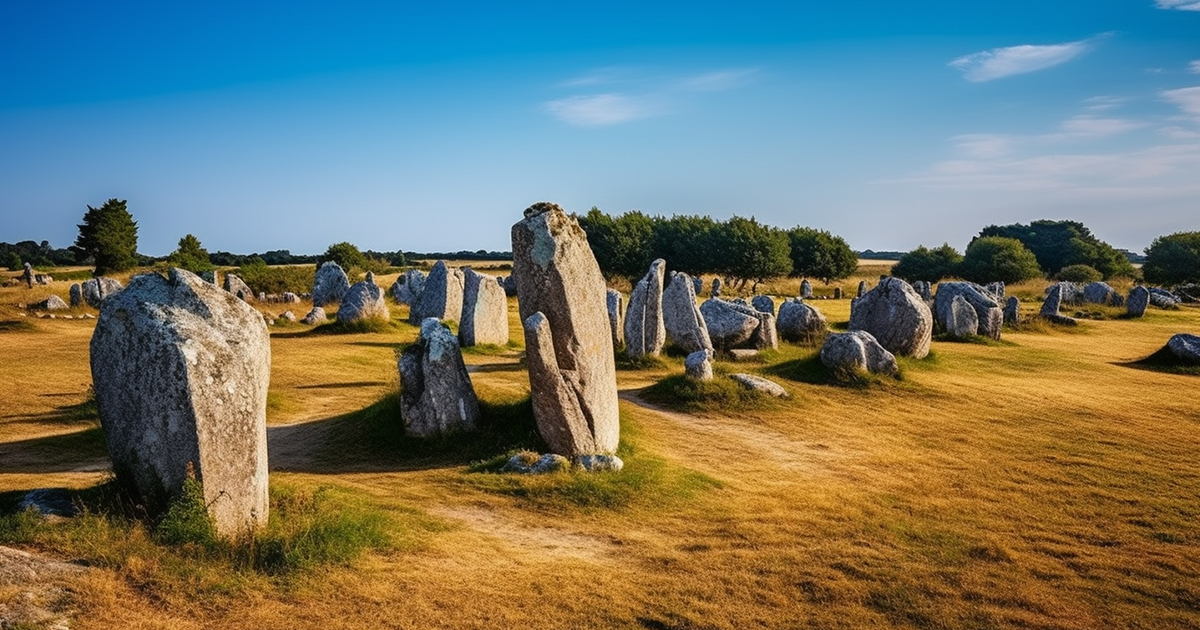Tucked away in the charming landscapes of Brittany, France, lies a remarkable archaeological site that has baffled researchers and history enthusiasts for ages — the Carnac Stones. Spanning over three kilometers, these ancient megalithic structures have intrigued minds with their enigmatic presence. Serving as a silent witness to the brilliance of an ancient civilization and its enigmatic connection to the universe, the Carnac Stones have stood the test of time, beckoning us to uncover their secrets.
Decoding the Origins of the Carnac Stones
Dating back to the Neolithic era, believed to be between 4500 and 3300 BCE, the Carnac Stones comprise a striking array of standing stones, aligned rows, dolmens, and tumuli. The sheer grandeur and precision of their construction continue to leave scholars pondering over the purpose behind their creation.

The primary alignment at Carnac consists of over 3,000 stones meticulously arranged in parallel rows extending from north to south. Ranging from small uprights to towering menhirs reaching heights of up to four meters, the placement of these stones with such precision, considering the technological limitations of the era, underscores the craftsmanship and knowledge possessed by the ancient architects.
Rich in Legends and Myths: Tales of the Carnac Stones
Throughout the centuries, the Carnac Stones have spawned myriad legends and myths, adding to their mystique. According to local folklore, the stones were once a legion of pagan warriors turned into stone by St. Cornelius, a Christian missionary. Another tale recounts how the stones represent a Roman legion petrified by Merlin, the fabled wizard of Arthurian lore.
While these mythical narratives are captivating, they are likely imaginative tales woven by later generations in an attempt to explain the inexplicable. The genuine purpose and significance of the Carnac Stones remain elusive, prompting researchers to rely on scientific inquiries for a more grounded understanding.
Exploring Theories and Ongoing Investigations
Various theories have surfaced over time, seeking to illuminate the purpose of the Carnac Stones. Some experts suggest that these stones served as astronomical markers, aiding in the observation of celestial events like solstices and equinoxes. The alignment of the stones with specific celestial positions lends credence to this notion.
Others theorize that the stones had religious or ceremonial connotations, functioning as a venue for rituals and communal gatherings. The abundance of stones and their meticulous arrangement likely held symbolic significance, symbolizing the community’s spiritual connections.
With advancements in archaeological technology, such as ground-penetrating radar and 3D mapping, new avenues of exploration have emerged. These tools have unveiled that the Carnac site extends far beyond the visible stones, potentially encompassing dwellings, temples, and more. This groundbreaking discovery hints at a complex societal structure and suggests a deeper purpose for the site.
Safeguarding the Enigmatic Legacy
The Carnac Stones serve as a tribute to the brilliance and wisdom of our ancestors, shrouded in the mysteries of time. As research progresses and technology offers fresh perspectives, we edge closer to unraveling the enigma of this extraordinary site.
Preservation endeavors are essential to ensure the Carnac Stones remain accessible for future generations to explore and study. Striking a balance between site accessibility and preservation is crucial. By backing archaeological studies and advocating sustainable tourism, we can ensure the legacy of the Carnac Stones endures for posterity.
A visit to the Carnac Stones today is a profound encounter, evoking awe at the magnitude and enigma surrounding these ancient monoliths. As we delve into the mysteries of our past, the Carnac Stones stand as an enduring marvel, beckoning us to delve into the depths of human history and the marvels of our ancient world.
